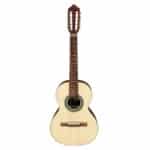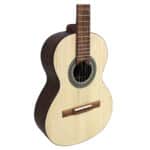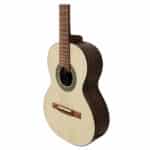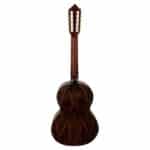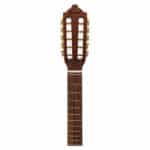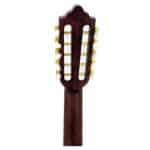Description
Giannini presents the new compensated brazilian violas from the Raiz series, VS1H and VS4H, developed after listening to what musicians would like to improve in their instrument. The models feature a compensated saddle with more appropriate octave compensation and more precise tuning; comfortable neck in “D” profile, as on Pantanal violas, ensuring pleasant playability; and 46 mm nut, for a better grip.
The VS1H and VS4H models are available in acoustic and electroacoustic versions, with a solid Marupá top and back and sides options in Gonçalo Alves and Imbuia (VS1H) or Louro Faia and Imbuia (VS4H). Matte finish.
The Woods
Marupá
It has excellent sound speed and an articulate tone, with dominant midranges (i.e., good treble and balanced bass). Used as a substitute for Spruce in the tops of acoustic instruments, and for Maple or Poplar in solid bodies. As it is a typical tree of floodplain forests, Marupá is common to be found in the Amazon region. With low density and grain, without visible veins (white-yellowish predominance in color), medium to coarse texture, it is easy to work with, dries quickly and allows for a good finish.
Imbuia
Its tone is very low-mid, but it balances the highs and defines the harmonics very clearly. Natural heir to Jacarandá-da-Bahia, Imbuia is also used in percussion and even on pianos. Native to subtropical areas of Brazil; found in the states of Paraná, Santa Catarina and Rio Grande do Sul, in slow-growing trees that reach up to 20 meters in height. Moderately heavy and quite stable, varied in color (ranging from a yellowish to brown tone, and generally with dark veins), little porous and very hard.
Brazilian Cedar
Widely used in solid instruments, due to its lightness and stability. The sound provided by Brazilian Cedro is characterized by a deeper and velvety tone, excellent bright definition (as it is not very resinous), good projection and sustain. Natural wood from open forests and fields with a hot/humid climate, widely distributed in the North region, mainly in the states of Acre, Amapá, Amazonas, Pará and Rondônia. It has low density, medium to thick texture, pinkish-beige color, and veins forming smooth regular designs.
Pau-Ferro
Used in acoustic instruments and in the creation of fingerboards and bridges. It produces pieces with good sound, beautiful finishing and excellent sustain, with a brighter tone than Rosewood, but which manages to retain the warmth for which Rosewood is celebrated. Its color varies from light yellowish brown to brownish brown, with dark veins forming characteristic and exotic irregular designs. Known for its rigidity, moderately light and very durable, Pau-Ferro is found in Goiás, Minas Gerais, Espírito Santo, São Paulo and Paraná states.
Features
What you will find in this model
-
Bi-directional Truss Rod
-
Temperada
Back and sides
What you will find in this model
-
 Imbuia
Imbuia
Shapes
Shapes available in this series
-
Classic Viola Shape
Nut Width
Sizes available in this series
-
Viola 46 mm
Sizes
Sizes available in this series
-
38"
Features
- Origem: Brasil
- Shape: Padrão clássico viola caipira, acústica
- Cor: Natural Satin
- Tampo: Marupá maciço
- Lateral e Fundo: Imbúia
- Braço: Cedro Brasileiro
- Tensor: Bi-direcional
- Escala: Pau-Ferro
- Comprimento da escala: 580 mm (22,83”)
- Cavalete: Pau-Ferro
- Tarraxas: Pino fino douradas
- Pestana: Osso
- Largura da pestana: 46 mm (1,81”)
- Rastilho: Osso, com compensação de oitava específica por corda
- Largura do rastilho: 82 mm (3,22”)
- Acabamento: Verniz fosco
- Cordas: Giannini Série Cobra GESVNL Leve
- Headstock: Cedro com filete em Imbúia
- Largura da caixa: 335 x 245 mm
- Altura da caixa: 95 x 107 mm
- Tamanho total: 95,5 cm (37,6”)
- Acompanha: Chave de ajuste do tensor, bateria 6F22 9V
*Product subject to change in his features without notice

